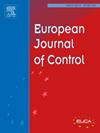A comparative study of sensitivity computations in ESDIRK-based optimal control problems
IF 2.6
3区 计算机科学
Q2 AUTOMATION & CONTROL SYSTEMS
引用次数: 0
Abstract
This paper compares the impact of iterated and direct approaches to sensitivity computation in fixed step-size explicit singly diagonally implicit Runge–Kutta (ESDIRK) methods when applied to optimal control problems (OCPs). We strictly use the principle of internal numerical differentiation (IND) for the iterated approach, i.e., reusing iteration matrix factorizations, the number of Newton-type iterations, and Newton iterates, to compute the sensitivities. The direct method computes the sensitivities without using the Newton schemes. We compare the impact of these sensitivity computations in OCPs for the quadruple tank system (QTS). We discretize the OCPs using multiple shooting and solve these with a sequential quadratic programming (SQP) solver. We benchmark the iterated and direct approaches against a base case. This base case applies the ESDIRK methods with exact Newton schemes and a direct approach for sensitivity computations. In these OCPs, we vary the number of integration steps between control intervals and evaluate the performance based on the number of SQP and QPs iterations, KKT violations, function evaluations, Jacobian updates, and iteration matrix factorizations. We also provide examples using the continuous-stirred tank reactor (CSTR), and the IPOPT algorithm instead of the SQP. For OCPs solved using SQP, the QTS results show the direct method converges only once, while the iterated approach and base case converges in all situations. Similar results are seen with the CSTR. Using IPOPT, both the iterated approach and base case converge in all cases. In contrast, the direct method only converges in all cases regarding the CSTR.
基于 ESDIRK 的最优控制问题中灵敏度计算的比较研究
本文比较了固定步长显式单对角隐式 Runge-Kutta (ESDIRK) 方法应用于最优控制问题 (OCP) 时,迭代法和直接法对灵敏度计算的影响。我们在迭代法中严格使用内部数值微分(IND)原理,即重复使用迭代矩阵因式分解、牛顿型迭代次数和牛顿迭代次数来计算灵敏度。直接法计算敏感度时不使用牛顿方案。我们比较了这些灵敏度计算对四水箱系统(QTS)OCP 的影响。我们使用多重射击对 OCP 进行离散化,并使用顺序二次编程 (SQP) 求解器进行求解。我们将迭代法和直接法与一个基本案例进行比较。该基础案例采用带有精确牛顿方案的 ESDIRK 方法和直接方法进行灵敏度计算。在这些 OCP 中,我们改变了控制区间之间的积分步数,并根据 SQP 和 QPs 的迭代次数、KKT 违反情况、函数评估、雅各布更新和迭代矩阵因式分解来评估性能。我们还提供了使用连续搅拌罐反应器(CSTR)和 IPOPT 算法代替 SQP 的示例。对于使用 SQP 求解的 OCP,QTS 结果显示直接方法只收敛一次,而迭代方法和基本情况在所有情况下都收敛。CSTR 也有类似的结果。使用 IPOPT 时,迭代法和基准法在所有情况下都收敛。相比之下,直接法只在 CSTR 的所有情况下收敛。
本文章由计算机程序翻译,如有差异,请以英文原文为准。
求助全文
约1分钟内获得全文
求助全文
来源期刊

European Journal of Control
工程技术-自动化与控制系统
CiteScore
5.80
自引率
5.90%
发文量
131
审稿时长
1 months
期刊介绍:
The European Control Association (EUCA) has among its objectives to promote the development of the discipline. Apart from the European Control Conferences, the European Journal of Control is the Association''s main channel for the dissemination of important contributions in the field.
The aim of the Journal is to publish high quality papers on the theory and practice of control and systems engineering.
The scope of the Journal will be wide and cover all aspects of the discipline including methodologies, techniques and applications.
Research in control and systems engineering is necessary to develop new concepts and tools which enhance our understanding and improve our ability to design and implement high performance control systems. Submitted papers should stress the practical motivations and relevance of their results.
The design and implementation of a successful control system requires the use of a range of techniques:
Modelling
Robustness Analysis
Identification
Optimization
Control Law Design
Numerical analysis
Fault Detection, and so on.
 求助内容:
求助内容: 应助结果提醒方式:
应助结果提醒方式:


